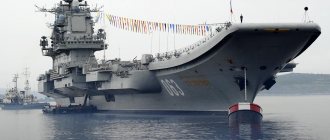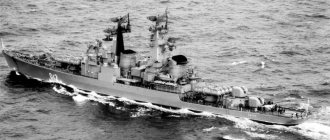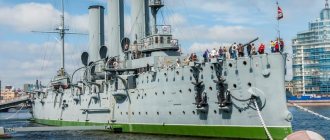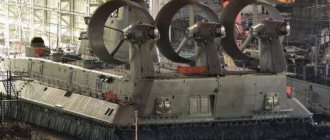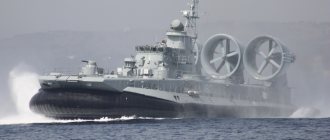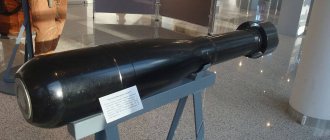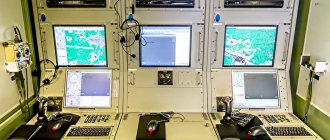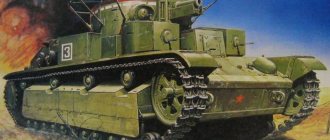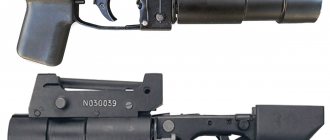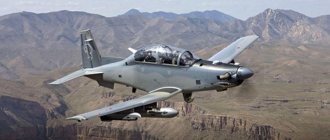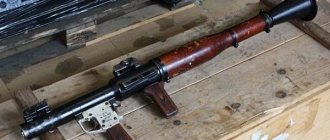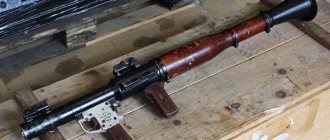Russian corvette Steregushchiy
A corvette is a type of small combat vessel designed to perform patrol and convoy functions. The main tasks of such a ship are to detect and combat enemy submarine and air forces.
The displacement of a corvette can vary from 500 to 1600 tons, the speed rarely exceeds 20 knots or 37 kilometers per hour.
As for weapons, corvettes usually carry on board missile or artillery installations with a caliber of up to 102 millimeters, anti-aircraft guns and bomb launchers for dropping depth charges. Occasionally, a corvette can be equipped with a torpedo tube.
In addition, corvettes have hydroacoustic and radar systems for air and underwater detection.
In their modern form, corvettes appeared shortly before the start of World War II. Interestingly, in the domestic classification, until recently, they belonged to the type of patrol ships, and the corvette, as a separate class, was identified only after the collapse of the USSR.
Destroyer
Destroyer "Sarych"
The destroyer or destroyer got its name in honor of the weapons of the first ships of this type. Initially, they were intended to create sea minefields, and also had torpedo tubes and small-caliber artillery to combat enemy ships.
Today, the main goals of destroyers are to combat air, underwater and surface targets as part of a squadron.
The weapons of these ships include missile launchers (formerly artillery), air defense systems and torpedo tubes.
It is somewhat incorrect to talk about the size and speed of this type of ship, since the understanding of destroyers in different countries varies somewhat.
For example, in Japan, the displacement of destroyers can reach 10,000 tons, in some countries it does not exceed 2,500. In Russia, the standard displacement of a destroyer is 6,500 tons, and the speed can reach 35 knots.
Destroyer and frigate: talking about the future
It seems that everything is clear and understandable with modern classes of warships, but this is if you just look at the terms “destroyer” and “frigate”. And if you are thoughtful, questions and bewilderments begin.
Yes, at first glance everything is clear - ships theoretically differ in displacement, armament, size, tasks... This is theoretical. But in practice...
But in practice there is a global naval mess. In general, the phenomenon on the waves is completely ordinary and familiar, much like an angry boatswain on a morning formation.
And it turns out that, in fact, there is no clear definition of classes as such! Not at all!
Here is an example of the well-known “Arleigh Burke” type. Total displacement 9,000 tons. This is a destroyer.
Here is his opponent, “Sarych”. Also a destroyer. Total displacement is under 8,000 tons.
And here is the Iranian Moudge-class destroyer Jamaran.
And its displacement... 1500 tons! That is, it seems to be a frigate or even a corvette, but in Iran these ships are called destroyers!
There is the Zamvolt with its almost 15,000 tons of displacement. There is a Chinese "Type 055" with 12,000 tons. It’s still under construction, but it will be built.
And if we add to this squadron the idea of a Project 23560 destroyer “Leader”, the displacement of which, according to papers, was close to 19,000 tons...
That is, whoever wants does what he wants.
With frigates, too, not everything is so simple; in general, this is probably the most controversial class in the ocean waves. It is enough to remember where it came from. From the French, who invented this small but nimble ship with one (later two) gun deck to fight pirates.
Since the frigate was mainly engaged in patrol service, reconnaissance, escort of merchant ships and raider service, which was then called cruising. And so it happened that some essentially frigates became cruisers. And when they received steam engines, turrets and armor, they first became steam frigates, and then official cruisers.
The gun deck became a thing of the past, and with it the very concept of a frigate disappeared around the end of the 19th century and did not appear until the mid-20th.
But at this time a destroyer appeared.
A small but very harmful ship with self-propelled mines, and later torpedoes. And later destroyers appeared, larger ships with stronger artillery, whose main task was to sink destroyers, protecting squadrons of large ships from them.
And during the Second World War, frigates appeared again. They were returned by the British, who were forced to come up with a new class of ships to protect the convoys.
The new frigate was not as well armed as the destroyer and was smaller. But this ship was larger than a patrol boat, and could escort transports across the ocean. And its weapons were enough to fight off German planes, and - most importantly - to drive submarines away from the convoy, which at that time were a real scourge of God for Great Britain.
The result was an intermediate class between destroyers and patrol boats, in fact an anti-submarine defense ship.
During the war, the Americans had their own ships, similar in characteristics to the British frigates. They were assigned to a subclass of destroyers: DES - Destroyer Escort Ships - escort destroyer.
After the war, they were reclassified as ocean-going escorts, since before the 1975 reclassification, "frigates" were light guided missile cruisers built to the size of destroyers. And then the Americans switched to the British classification system.
Indeed, the British frigate was between a destroyer and a boat, and the American one was between a cruiser and a destroyer. And NATO demanded at least approximate uniformity.
Today, the line between a frigate and a destroyer is gradually blurring. In general, the destroyer is still slightly larger than a frigate, somewhat heavier armed, and possibly faster.
If we take the old Project 956 destroyer Sarych as an example and compare it with the Project 22350 frigate Admiral Gorshkov, then in terms of displacement the Sarych is larger than the frigate, 8,000 tons versus 5,400 tons. The destroyer's speed is also higher, 33 knots versus 29 for the frigate. The range of the ships is approximately the same, about 4,500 miles.
Frigate "Admiral Gorshkov"
But in terms of weapons, everything is not so clear.
The destroyer's artillery armament is stronger. 2 AK-130 gun mounts (4 130 mm barrels) versus one 130 mm A-192M mount.
Anti-aircraft artillery is stronger on a destroyer. 4 x 6 x 30 mm ZAU AK-630 versus 2 x 1 x 30 mm ZAK "Broadsword".
The frigate has better anti-aircraft missile weapons, the Redut is definitely better than the Uragan (this is the naval version of the Buk). A destroyer has more missiles in a salvo, but still the Redoubt is a new generation.
Well, the main weapon of the ship is tactical missiles. 2 x 4 anti-ship missiles P-270 “Moskit” for the destroyer versus 2 x 8 “Oniks”, “Zircon”, “Caliber” for the frigate. And in the future, the next models will have 4 x 8, that is, 32 launch cells.
Well, let’s be honest – “Mosquito” has been outdated for a long time. And even if it is replaced with something modern, the frigate will still have more “trunks”.
The frigate's mine and torpedo armament is also better.
In general, it is clear that today the new frigate is much more effective than the old destroyer. In addition, frigates are somewhat cheaper, although this has always been the case. This made it possible to churn out frigates like pies.
Here it is worth looking at the experience of the PRC. The Chinese significantly separated the two classes of ships. Type 052D Kunming destroyers, which form the backbone of the naval strike force, have a displacement of 7,500 tons and carry 64 launchers.
Frigates of type 053N3 "Jiangwei-2" are much lighter (2500 tons) and carry weapons to a minimum, like normal frigates: 8 launchers for anti-ship missiles and 4 launchers for air defense systems.
The Japanese fleet has approximately the same weight distribution. Only the Abukuma-class frigates, of which there are only 6, are even lighter in armament than the Chinese ships. Well, the Japanese destroyers, whether “Kongo” or “Atago”, are generally relatives of the “Arly Berkam”.
The difference between classes, oddly enough, is beginning to disappear today. It has already been said on our pages that the Arleigh Burke is ¾ of the Ticonderoga, and if you take and place next to the American cruiser the new Chinese destroyer of Project 055, it will become clear that the cruiser is very light (9,800 tons), or the Chinese destroyer was fattened (12,000 tons). But a cruiser is smaller than a destroyer - this somehow does not fit into the picture.
Approximately the same thing will happen in the lower class, where corvettes (for example, Project 20385 corvettes of the Steregushchiy type) are quite close to the heels of frigates. The same 2,500 tons of displacement, the same 8 cells for launching anti-ship missiles of the “Caliber”, “Onyx”, “Zircon” type, the same “Redut” as an air defense and so on.
And such a corvette can easily attack another frigate one on one. Or an Iranian “destroyer”, if it turns up under the bow.
Sorry, but where is the difference then?
In a good way, there are only two classes of ocean-going ships left in the world, besides aircraft carriers. These are large ships (cruisers, destroyers) and small ones (frigates and corvettes). Roughly speaking, how can one not remember the classification of the Soviet fleet, where there were ships of 1st and 2nd ranks.
And there are not so many cruisers as such in the world. Seriously though, 2.5 Russian heavy cruisers, 3 missile cruisers and 22 American Ticonderogas are, in general, all the cruisers for today. Not so much, and given the more than veteran age of the cruisers, we can assume that in 10 years only a few will remain from this detachment.
And the main force (I don’t take aircraft carriers into account) in the majority of the world’s decent fleets will be the destroyer. Which will not be inferior in its capabilities to cruisers. The same 112 UVP of the Chinese Type 055 are not much inferior to the 122 UVP of Ticonderoga.
In general, cruisers will go down in history, just as their linear relatives and then battleships once did.
The main striking force at sea will continue to be an aircraft carrier and a destroyer mutated to the size of a cruiser. And frigates and corvettes will work as cover ships and various escort operations (and to chase pirates), which will obviously also merge into one class.
At least today, it is becoming very difficult to distinguish a frigate from a corvette. But this is a topic for another discussion.
Frigate
Project 22350 frigate
In terms of size and maneuverability, modern frigates are very close to destroyers. However, if a destroyer is capable of fighting all types of targets: surface, underwater, air, then frigates concentrate only on fighting enemy submarines and aircraft.
They also have missile weapons, but they are not enough to effectively counter enemy ships.
Definition
A frigate is a medium-displacement warship that performs defensive and attack missions. In the sailing fleet, it was a three-masted, sail-rigged, gun-deck (two gun-deck) vessel. During military operations, frigates, as a rule, did not participate in linear combat operations, but acted as independent combat units or flagships of squadrons. Frigates were smaller in size than battleships.
Frigate
A corvette is also a warship. It has its own technical characteristics, equipment and purpose. Being a sailing ship, the corvette had sailing weapons similar to those of the frigate.
Corvette
Cruiser
Missile cruiser "Moscow"
The cruiser is perhaps the most versatile modern type of ship, since it is the only ship capable of performing tasks both independently and as part of a squadron.
Currently, this type of ship is actively used only by the US and Russian Navy. In other countries, if frigates are found, it is in very small numbers.
The main task of these ships is to combat enemy surface forces.
Cruisers primarily carry missile weapons and may also have a small amount of air defense systems.
Until recently, cruisers had an extensive classification of their own. For example: battle cruisers, air defense cruisers, light, heavy, linear and even aircraft-carrying cruisers. However, by the end of the 20th century this classification was abolished.
Displacement of modern cruisers: up to 10,000 tons. Speed: 30-40 knots.
Armadillo
Armadillos appeared in the second half of the 19th century, when it became possible to create ships equipped with powerful armor, powerful weapons and a sufficient power plant so that the ship could move with all this. A characteristic feature of battleships is the presence of several (usually three) groups of artillery, differing in caliber: large, medium, small.
Battery battleship
Casemate battleship
Barbet armadillo
Turret battleship
Battleships
The battleship of the Russian/Soviet fleet “Sevastopol” was decommissioned in 1956.
I don’t think it’s worth talking much about battleships. In the mid-twentieth century, these ships were real sea monsters - huge and heavily armed, but the Second World War showed their inconsistency and after it no one else was engaged in the construction of battleships, and the remaining ones were slowly decommissioned.
Rank I[]
Battleship (LC)
- the most powerful artillery ships, well armored, but not too mobile. Designed to destroy ships of all classes, orbital structures and orbital bombardment of planetary surfaces.
Battlecruiser (LinKR)
– a lightweight version of the battleship due to armor. A more mobile battlecruiser is designed not only for linear battles, but also for raiding and reconnaissance operations. Covering the flanks of the squadron, escorting aircraft carriers. Starting from this class, ships can carry weapons of the planet destroyer class.
Heavy (attack) aircraft carrier (AVC)
– large aircraft-carrying ships, designed for the destruction by forces of an air group, space targets of all types, direct support of troops, gaining superiority in space cubic capacity, strike operations, providing air defense\anti-missile defense bases and formations.
Amphibious assault carrier (AVC)
- a type of heavy aircraft carriers designed for basing and landing infantry formations. Usually they are somewhat larger in size than their AVT brothers.
The combat orbital platform (BOP) is a large space fortress city, armed and armored at the level of a battleship.
Dreadnought (D)
- aka “super battleship”. The largest ships of the Aerospace Forces of the superpowers, combining the power of a battleship and the capabilities of a heavy aircraft carrier.
Essential elements
Any type of sailing ship is a device that consists of a hull that houses the crew, provisions, and necessary equipment.
The horizontal area on top of the ship is called the deck. The rear and front elements of the hull, respectively, are the stern and bow, the underwater part from below is the keel, the restrictions are on two sides - the starboard and left sides.
The structure of the sailing ship also includes:
- sails (straight and oblique);
- rigging - running and standing (all kinds of chains, metal, rope ropes);
- spar (masts with gaffs, yards, bowsprit, boom, topmasts).
Sailors call a bowsprit a beam that is a continuation of the bow and is located at an angle to the surface of the sea surface, where the oblique sails are attached.
The gaff is a yard, which is inclined at an angle to the mast, and a trapezoidal oblique sail is attached here. The boom is a horizontal yard from below. The topmast is fixed to the mast and is its continuation.
Standing rigging, as the name suggests, is stationary. These tackles reliably fasten topmasts and masts, and they have the following varieties:
- backstays that secure the bowsprit;
- stays securing the masts in front;
- forduns and shrouds located on the sides (reminiscent of a rope ladder).
The following types of rigging exist:
- sheet (required to control sailing equipment);
- tack (fixes the inclination of the sail relative to the boom, bowsprit, deck);
- brace (necessary to turn the yard horizontal to the deck in a plane);
- halyard (required to raise the sail).
The classification of sails is based on a number of criteria. Their shapes come in the form of a rectangle, triangle, and trapezoid.
By location - along the hull or across - the upper and lower sails (upper fore-topsail, lower fore-topsail), oblique (jib, staysail - both are additional) and straight (topsail, topsail, mainsail).
There are also lateen sails - they have the shape of a triangle, attached to the yard with the long part, inclined to the mast at an angle of about 44-57 degrees.
https://youtube.com/watch?v=mCq5vUHAuN4
External links [edit]
Media related to Naval ships at Wikimedia Commons?
| vteNaval ships and warships in the late modern era | |
| |
| Aircraft carriers |
|
| Battleships |
|
| Cruisers |
|
| Escort |
|
| Transport |
|
| Patrol ship |
|
| Fast attack ship |
|
| Mine warfare |
|
| Command and support |
|
| Submarines |
|
| Various |
|
How is a battleship different from a destroyer or battleship?
A battleship is the most heavily armed and protected artillery ship.
The Russian-language name comes from the fact that these ships were intended for “linear combat,” that is, when the ships lined up one after another (wake column) and killed the enemy with broadside salvos. Battleships appeared back in the era of the sailing fleet (displacement up to 2-3 kt, armament up to 140 guns). When sailing ships began to leave the historical arena, a rather long period of searching began for the optimal design of an all-metal warship. It all started with small armored monsters, armed with 1-2 large-caliber guns, which the British called ironclad, and the Russians called battleships.
In the end, the design of the “classic battleship” was established. It was a ship with a displacement of about 10-15 kt, armed with four 305 mm guns in two turrets and 12-16 rapid-fire 152 mm guns in casemates or one-two-gun turrets. The most famous Russian classic battleship was the Potemkin. The British called these ships battleship, the Russians called them battleships, but at the beginning of the 20th century. Russian battleships were renamed battleships. From that time on, the concepts of “battleship” and battleship became identical and meant the largest, heavily armed and heavily armored artillery ship. The term “battleship” has since been used in Russian only in a historical aspect.
During the Second World War, battleships lost their leading military importance at sea, giving way to aircraft carriers and submarines. The last battleships (four American Iowa-class battleships) remained in the fleet until the 1980s and were used for artillery support for ground operations in coastal areas. They had a displacement of 50+ kilograms and a main caliber of nine 406 mm guns.
Destroyers were originally small boats designed to attack enemy ships with torpedoes. Over time, their size and speed increased, seaworthiness improved, and artillery appeared. Destroyers capable of operating as part of a squadron (that is, fast enough and seaworthy) began to be called in Russian squadron destroyers or destroyers. In English, their name has not changed - destroyer. The classic destroyer of the Second World War is a ship with a displacement of 2-3 kt, with a speed of 35-40 knots, armed with guns of 100-130 mm caliber. It was the weakest and fastest of the major surface combatants. The main task is air defense and anti-aircraft defense.
In the 1950s, gunships began to retire from the historical arena, and the meaning of the term "destroyer" changed. Now it is a universal missile ship with a displacement of 6-10 kt, designed for air defense and anti-aircraft defense, as well as artillery support for landing forces. Not counting aircraft carriers, it is the largest of the major surface combatants.
In Russia, the classification of ships is somewhat different. The Western term “destroyer” roughly corresponds to “large anti-submarine ship”. The Russian “destroyer” (we currently have only one type of destroyer - Project 956) is a ship with a displacement of approximately 8 kt, designed to destroy enemy ships (for this it is armed with supersonic anti-ship missiles), air defense and artillery support. There are no similar ships in the west.
otvet.mail.ru
Supply ships
Naval bases and ports located on the coast with the current means of destruction are not capable of being a stable system for basing the fleet. A mobile-based system can be considered more adapted to modern conditions. As a result, with the new structure of the naval forces, support ships arose, used for logistical support of the fleet.
The main task of such ships is to provide combat ships on the high seas with the necessary means and equipment. Such ships include:
- floating bases are aimed at providing ships with weapons and ammunition, spare parts, fuel, water, electricity and other things. There are bases involved in servicing:
- submarines
- destroyers
- mine countermeasures ships
- torpedo boats
- repair tools designed to repair ship systems. Such as weapons, fire control devices, engines, mechanisms and hull elements. Consists of floating workshops and floating docks;
- Supply vessels are engaged in escorting warships and supplying them with the necessary resources. Supply ships can be divided into general purpose supply ships, squadron supply tankers, squadron dry cargo supply ships and specialized supply ships;
- research ships and devices, are engaged in developing and testing new ship techniques and weapons systems
- rescue support ships, can be divided into submarine rescue ships, surface rescue ships, fire fighting ships and ship lifting equipment;
- special ships testing space systems support weapons. They are training targets for firing at a moving target. The target can be towed or self-propelled, controlled by radio. The latter also requires a driver ship.;
- training ships serve for training ship personnel and training squads.
Also, naval bases and fleet ships are supported by basic floating assets of the Navy, each of them performs a specific function: transporting resources, supplying ships with fuel and water, piercing ice for the movement of ships, and others. These include icebreakers, tugs, self-propelled and non-self-propelled barges, tankers, water carriers and other types of floating installations.
Table of contents
Section one. STRUCTURE OF THE SHIP AND EQUIPMENT OF THE UPPER DECK
Return of the cruiser "Marshal Ustinov"
Chapter 1. Construction of a surface ship and submarine
1.1.
Structure of a surface ship1.2. Surface ship protection 1.3. Submarine structure 1.4. Spar and rigging Chapter 2. Equipment of the upper deck of a surface ship and submarine
2.1.
Mooring device 2.2. Towing devices 2.3. Railing and awning devices, ladders and shots 2.4. Davits Chapter 3. Anchor device
3.1. Anchor device diagram 3.2. Classification and basic technical data of anchors 3.3. Types of anchors 3.4. Anchor chains 3.5. Stoppers for anchor chains and anchors 3.6. Anchor and deck hawse, chain pipes and boxes 3.7. Lifting anchor mechanisms 3.8. Caring for the anchor device 3.9. Safety precautions when working with an anchor device
Section two. CABLES, RIGGING EQUIPMENT AND SCALVING
Chapter 4. Cables
4.1.
Steel cables4.2. Plant cables4.3. Synthetic cables Chapter 5. Items of rigging equipment
5.1.
Blocks5.2. Gaki5.3. Staples5.4. Turnbuckles, butts, eyes, thimbles and rigging chains Chapter 6. Rigging work
6.1.
Tools and accessories for rigging6.2. Sea knots6.3. Rigging work with cables Chapter 7. Canvas and products made from it
7.1. Articles, varieties and impregnations of canvas7.2. Rules for acceptance, repair, painting and storage of canvas
Section three. Contents of the SHIP
Chapter 8. Ship work
8.1.
Inspections of the ship's hull8.2. Caring for the ship's hull 8.3. Ship tidy 8.4. Safety measures during ship work Chapter 9. Painting the ship
9.1. Corrosion and its control 9.2. Components of paints and varnishes 9.3. Oil-based paints and varnishes 9.4. Paints and varnishes based on resin (natural and synthetic) 9.5. Adhesives and their use 9.6. Tools and materials used in painting work 9.7. Organization of painting work and safety measures
Section four. LOADING AND UNLOADING WORKS ON A SHIP
Chapter 10. Ship's lifting devices
10.1.
Gordeni and tali10.2. Portable load beams, booms and cranes10.3. The simplest devices for lifting operations Chapter 11. Receiving cargo onto the ship
11.1. Organization of loading operations 11.2. Reception of food and drinking water11.3. Reception of fuel11.4. Loading heavy cargo 11.5. Basics of operating lifting devices 11.6. Safety measures during loading and unloading operations
Section five. SHIP FLOATING AND RESCUE EQUIPMENT
Chapter 12. Ship's watercraft
12.1.
Purpose and classification12.2. Ship's boats12.3. Ship's motor boats12.4. Placement of ship's watercraft, launching them into the water and lifting them onto the ship 12.5. Operating motor boats and lifeboats 12.6. Maintenance of ship's watercraft Chapter 13. Life-saving equipment
13.1. Personal life-saving equipment13.2. Collective life-saving equipment13.3. Staying at sea on collective life-saving equipment
Section six. EQUIPMENT OF RAIDS AND HARBORS. DOCKING
Chapter 14. Equipment of roadsteads and harbors
14.1.
Raid barrels and bridles14.2. Dead anchors14.3. Mooring equipment of piers and harbors Chapter 15. Docks and ship-lifting structures
15.1. Methods for docking ships 15.2. Dry docks15.3. Loading docks15.4. Floating docks15.5. Slips, slips
